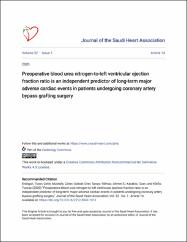| dc.contributor.author | Erdoğan, Turan | |
| dc.contributor.author | Çetin, Mustafa | |
| dc.contributor.author | Çinier, Göksel | |
| dc.contributor.author | Özer, Savaş | |
| dc.contributor.author | Yılmaz, Ahmet Seyda | |
| dc.contributor.author | Karakişi, Ozan | |
| dc.contributor.author | Koros, Tuncay | |
| dc.date.accessioned | 2020-12-19T19:35:19Z | |
| dc.date.available | 2020-12-19T19:35:19Z | |
| dc.date.issued | 2020 | |
| dc.identifier.citation | Erdoğan, T., Çetin, M., Çinier, G., Özer, S., Yõlmaz, A. S., Karakişi, O., & Kõrõş, T. (2020). Preoperative blood urea nitrogen-to-left ventricular ejection fraction ratio is an independent predictor of long-term major adverse cardiac events in patients undergoing coronary artery bypass grafting surgery. Journal of the Saudi Heart Association, 32(1), 79–85. https://doi.org/10.37616/2212-5043.1013 | en_US |
| dc.identifier.issn | 1016-7315 | |
| dc.identifier.issn | 2212-5043 | |
| dc.identifier.uri | https://doi.org/10.37616/2212-5043.1013 | |
| dc.identifier.uri | https://hdl.handle.net/11436/1269 | |
| dc.description | WOS: 000561428000014 | en_US |
| dc.description | PubMed: 33154896 | en_US |
| dc.description.abstract | Background: Long-term mortality rate following coronary artery bypass grafting (CABG) procedure is still considered to be high despite advances in surgical techniques and perioperative management. Identifying high-risk patients by using cost-effective and clinically useful parameters is needed. Methods: Patients who were admitted to our cardiology clinic with the diagnosis of coronary artery disease and underwent CABG between January 2008 and August 2010 were included. Study patients were followed-up for 112.6 +/- 17.8 months for major adverse cardiac events (MACE) which were defined as all-cause mortality and new-onset decompensated heart failure (HF). Results: Patients in MACE (+) group were older (p < 0.001), had higher additive Euroscore (p < 0.001), and lower left ventricular ejection fraction (p < 0.001). Multivariate Cox regression analysis showed that additive Euroscore [odds ratio (OR) = 1.601; 95% confidence interval (CI) = 1.374-1.864; p < 0.001)] and blood urea nitrogen-to-left ventricular ejection fraction ratio (BUNEFr; OR = 1.028; 95% CI = 1.006-1.050; p = 0.011) independently predicted MACE. Receiver operating characteristic curve analysis demonstrated that BUNEFr had an area under curve of 0.794 and BUNEFr >33 had a sensitivity and specificity of 74% and 64%, respectively. Conclusion: BUNEFr is a clinically useful and cost-effective parameter for the prediction of long-term mortality and new-onset decompensated HF in patients undergoing CABG. | en_US |
| dc.language.iso | eng | en_US |
| dc.publisher | Digital Commons Bepress | en_US |
| dc.rights | info:eu-repo/semantics/openAccess | en_US |
| dc.subject | Blood urea nitrogen | en_US |
| dc.subject | Coronary artery bypass grafting | en_US |
| dc.subject | Left ventricular ejection fraction | en_US |
| dc.subject | Major adverse cardiac event | en_US |
| dc.title | Preoperative blood urea nitrogen-to-left ventricular ejection fraction ratio is an independent predictor of long-term major adverse cardiac events in patients undergoing coronary artery bypass grafting surgery | en_US |
| dc.type | article | en_US |
| dc.contributor.department | RTEÜ, Tıp Fakültesi, Dahili Tıp Bilimleri Bölümü | en_US |
| dc.contributor.institutionauthor | Erdoğan, Turan | |
| dc.contributor.institutionauthor | Çetin, Mustafa | |
| dc.contributor.institutionauthor | Özer, Savaş | |
| dc.contributor.institutionauthor | Karakişi, Ozan | |
| dc.identifier.doi | 10.37616/2212-5043.1013 | |
| dc.identifier.volume | 32 | en_US |
| dc.identifier.issue | 1 | en_US |
| dc.identifier.startpage | 79 | en_US |
| dc.identifier.endpage | 85 | en_US |
| dc.ri.edit | oa | en_US |
| dc.relation.journal | Journal of the Saudi Heart Association | en_US |
| dc.relation.publicationcategory | Makale - Uluslararası Hakemli Dergi - Kurum Öğretim Elemanı | en_US |


















